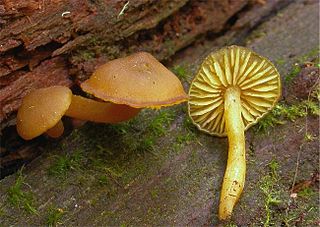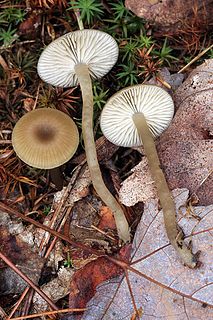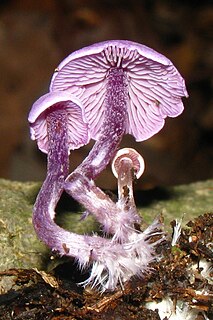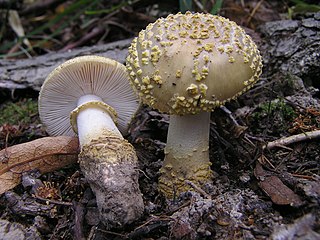
Omphalotus is a genus of basidiomycete mushroom, in the family Marasmiaceae, formally circumscribed by Victor Fayod in 1889. Members have the traditional cap and stem toadstool form. They are saprobic, and fruit in clumps on trees. The best known and type species is the jack-o'-lantern mushroom (Omphalotus olearius). Species of Omphalotus have been mistaken for chanterelles. All Omphalotus species are presumed poisonous, causing gastrointestinal symptoms. Some Omphalotus species have bioluminescent properties.

Pholiotina is a genus of small agaric fungi. It was circumscribed by Swiss mycologist Victor Fayod in 1889 for Conocybe-like species with partial veils. The genus has since been expanded to include species lacking partial veils.
Schinzinia is a fungal genus in the family Agaricaceae. It is a monotypic genus, containing the single species Schinzinia pustulosa. The genus was circumscribed by Swiss mycologist Victor Fayod in 1889.
Austroomphaliaster is a fungal genus in the family Tricholomataceae. It is a monotypic genus, containing the single species Austroomphaliaster nahuelbutensis, found in temperate South America.

Callistosporium is a genus of fungi in the family Tricholomataceae. The genus is widespread, and contains 13 species.

Cellypha is a genus of fungi in the family Tricholomataceae. The widespread genus contains 10 species.
Dennisiomyces is a genus of fungi in the family Tricholomataceae. Described by mycologist Rolf Singer in 1955, the genus contains five species found in South America.

Fayodia is a genus of fungi in the family Tricholomataceae. It was first described by Robert Kühner in 1930, and the specific epithet honors the Swiss mycologist Victor Fayod. The widespread genus contains 10 species, mostly in the northern temperate regions.

Gamundia is a genus of fungi in the family Tricholomataceae. The genus contains six species found in Europe and temperate regions of South America.

Leucoinocybe is a fungal genus in the family Tricholomataceae. This genus is known to contain 3 species: Leucoinocybe lenta and Leucoinocybe taniae, found in Europe, and Leucoinocybe sulcata found in India.

Mycenella is a genus of fungi in the family Tricholomataceae. The widespread genus contains 10 species, found mostly in temperate regions. Mycologist Rolf Singer circumscribed the genus in 1938.

Pseudobaeospora is a genus of fungi in the family Tricholomataceae. A 2008 estimate placed about 20 species in the widespread genus.

Pseudoclitocybe is a genus of fungi in the family Tricholomataceae. The genus contains about ten species with a collectively widespread distribution.

Cystoderma carcharias, is a species of agaric in the fungal family Agaricaceae. It has a widespread distribution, and has been collected in coniferous forests and grasslands in Asia, Europe, North America, and the subantarctic islands. In the field, fruit bodies are characterized by a pink cap up to 6 cm (2.4 in) broad, a well-developed ring on the stem, and an unpleasant odour.
Adustomyces is a fungal genus in the family Pterulaceae. The genus is monotypic, containing the single resupinate species Adustomyces lusitanicus, found in Europe and Africa. Adustomyces was described by Swiss mycologist Walter Jülich in 1979.

Amanita franchetii is a species of fungus in the family Amanitaceae. It was given its current name by Swiss mycologist Victor Fayod in 1889 in honor of French botanist Adrien René Franchet. A. franchetii occurs in Europe and North Africa with oaks, chestnuts, and pines.
Conocybe moseri is a mushroom species in the family Bolbitiaceae. It was described as new to science in 1980 by mycologist Roy Watling, from collections made in France. The specific epithet moseri honours Austrian mycologist Meinhard Moser. The fungus has been reported from the United Kingdom, growing in grassy areas, fields, and edges of woods. In 1995, it was recorded from Switzerland, from Ukraine in 2007, and from Russia in 2007. It was reported from India in 2015, where it was found growing on cattle dung.












